We may be compensated if you purchase through links on our website. Our team is committed to delivering honest, objective, and independent reviews on home products and services.
Project details
Skill
Cost
Estimated Time
Roof soffits are vital in protecting your home from the elements and maintaining proper ventilation. However, they are often susceptible to damage from water, pests, and weather conditions. This guide walks you through the process of repairing a rotted soffit, providing expert advice to help you tackle this important home maintenance task. Whether you’re a DIY enthusiast or considering professional help, understanding the steps involved in soffit repair will ensure your home remains protected and visually appealing.
*Unless otherwise noted, costs in this article reflect an average of prices that our team found from hardware stores like Lowes and Home Depot, and on Amazon.com.
Soffit and Fascia Repair
Repairing a damaged soffit and fascia is a multi-step process that requires attention to detail and the right tools. This section will guide you through each step, from removing the old, damaged components to installing new ones. By following these instructions carefully, you can effectively repair your roof’s soffit and fascia, preventing further damage and improving your home’s overall appearance.
1. Remove Shingle Mold
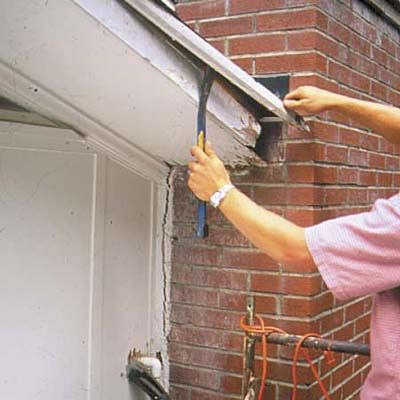
Begin the repair process by carefully removing the shingle mold from the fascia. This step is necessary for accessing the damaged areas and preparing for the installation of new components.
Using a flat bar, gently pry the narrow shingle mold away from the fascia. Work slowly and methodically to avoid splitting the mold. If you can remove it intact, set it aside for potential reuse later in the project. This careful removal not only preserves materials but also maintains the original aesthetic of your roof’s edge.
2. Remove Rotted Fascia
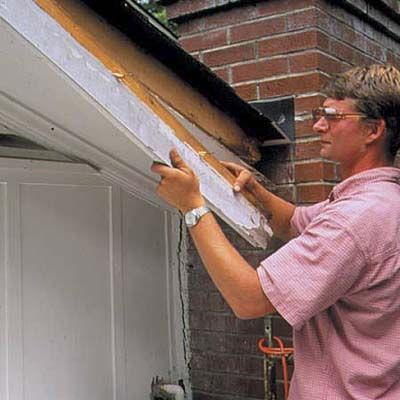
Once the shingle mold is removed, you can access the damaged fascia board. This step requires precision to avoid causing additional damage to surrounding areas.
Carefully remove the rotted section of the fascia board. Depending on the extent of the damage, use appropriate tools, such as a pry bar or reciprocating saw. Exercise caution to prevent damaging nearby roof shingles or flashing.
3. Remove Old Soffit
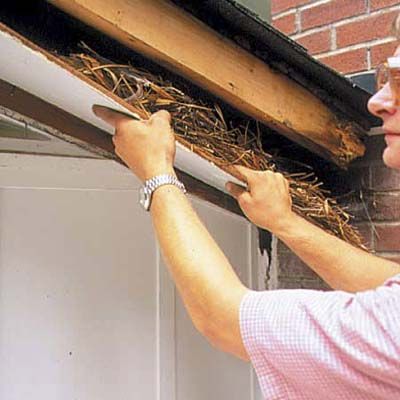
After addressing the fascia, it’s time to remove the old, damaged soffit. This step often reveals the full extent of the damage and may uncover additional issues.
Pull down firmly to remove the old soffit. Be prepared for surprises—in some cases, you may discover that animals have made nests in the space above the soffit, as shown in the image where a squirrel had built a large nest. This discovery underscores the importance of regular inspections and timely repairs to prevent pest infestations.
4. Remove Rotted Rafter
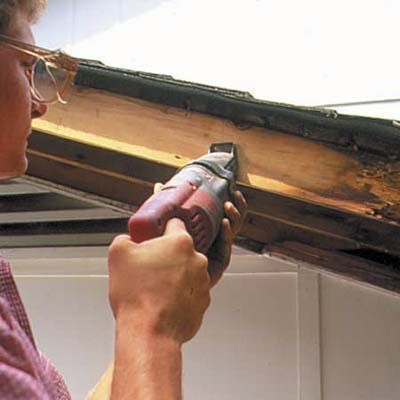
Inspect the exposed rafters for any signs of rot or damage. If you find a rotted rafter, it’s essential to replace it to ensure the structural integrity of your roof overhang.
Use a reciprocating saw to carefully cut out the rotted portion of the rafter. Once removed, measure the space and cut a replacement piece from pressure-treated lumber. Pressure-treated wood is ideal for this application due to its resistance to moisture and decay, providing long-lasting protection against future damage.
5. Attach Cleat
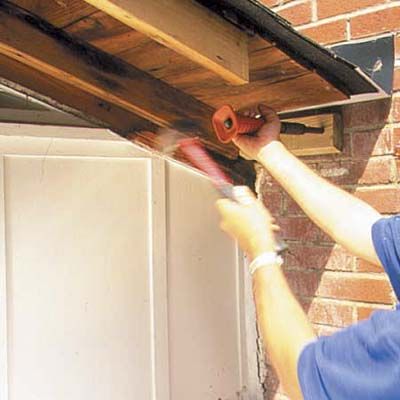
In some cases, you may need additional support for the new overhang, especially if the repair involves areas near chimneys or other structural elements.
To provide extra support, use a powder-actuated nailer to attach a 2×4 cleat to the brick chimney or other solid surface. This cleat will help support the weight of the new overhang and ensure its stability. Always follow safety guidelines when using powder-actuated tools and wear appropriate protective gear.
6. Attach New Rafter
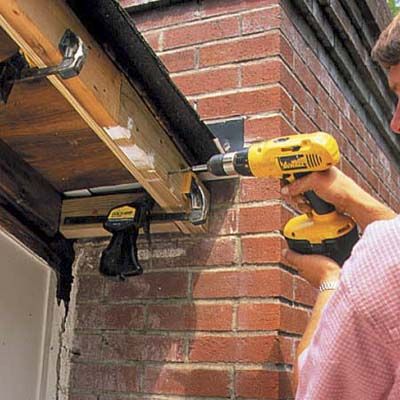
With the support cleat in place, you can now install the new rafter to replace the rotted one removed earlier.
Begin by clamping a backing board in place to provide additional support. Then, carefully position the new rafter and secure it to the backing board using screws. Also, attach the rafter to the chimney cleat you installed in the previous step. This double attachment method ensures a sturdy and long-lasting repair.
7. Seal Replacement Soffit
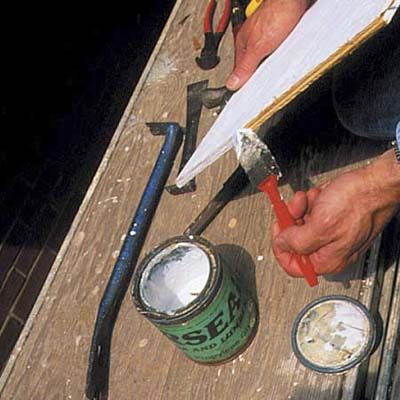
Before installing the new soffit, protect it from potential water damage. This step helps extend the life of your repair and prevents future issues.
Apply a waxy sealer, such as AnchorSeal, to the edges of the plywood soffit. This sealer creates a barrier against water penetration, helping to prevent rot and extend the life of your new soffit. Be sure to cover all exposed edges thoroughly for maximum protection.
8. Attach Replacement Soffit
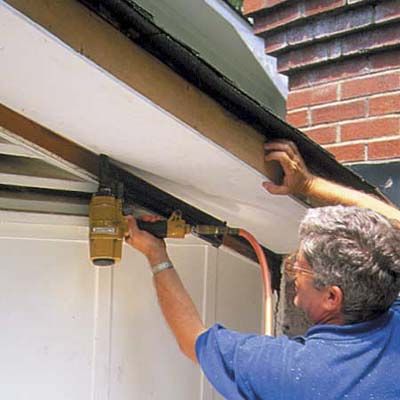
After completing the preparatory steps, you can install the new soffit. This step is essential for restoring the appearance and functionality of your roof’s overhang.
Before attaching the new plywood soffit, prime both the top and bottom surfaces. This priming helps protect the wood from moisture and improves paint adhesion. Once primed, carefully fasten the soffit to the underside of the eave or rake using appropriate fasteners. Ensure a snug fit against the existing structure for a seamless appearance.
9. Replace Crown Molding
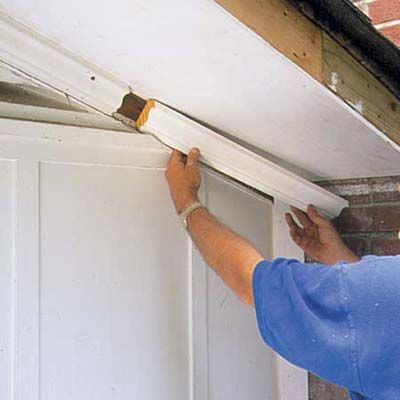
To complete the soffit repair, you’ll need to replace any crown molding removed or damaged during the process.
Install a new section of crown molding along the house’s wall, directly beneath the rear edge of the new soffit. This molding not only enhances the repair’s aesthetic appeal but also helps to seal any gaps between the soffit and the house, preventing water intrusion and pest entry.
10. Attach Replacement Fascia
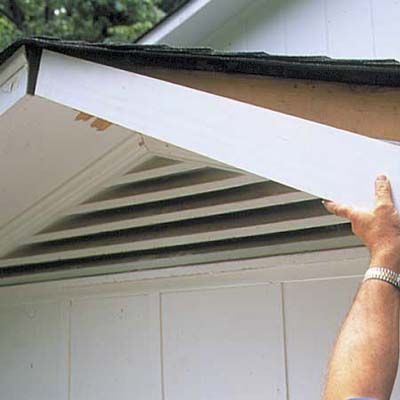
With the soffit in place, it’s time to install the new fascia board. This step restores the finished appearance of your roof’s edge.
Carefully slide the new fascia into place, ensuring it aligns properly with the existing fascia boards. Attach it securely using galvanized nails, which resist rust and provide a long-lasting hold. After nailing, set the nail heads slightly below the surface and fill the holes with wood putty for a smooth finish.
11. Attach Shingle Mold

The final step in the repair process involves reattaching the shingle mold, which provides a finished edge to your roof line.
If you could salvage the original shingle mold, reattach it along the top of the fascia. If not, install a new one. Secure the mold with appropriate fasteners, taking care not to split the wood.
Tools
 Flat pry bar
Flat pry bar Reciprocating saw
Reciprocating saw Nailer
Nailer Drill/driver
Drill/driver Clamps
Clamps Tape measure
Tape measure







